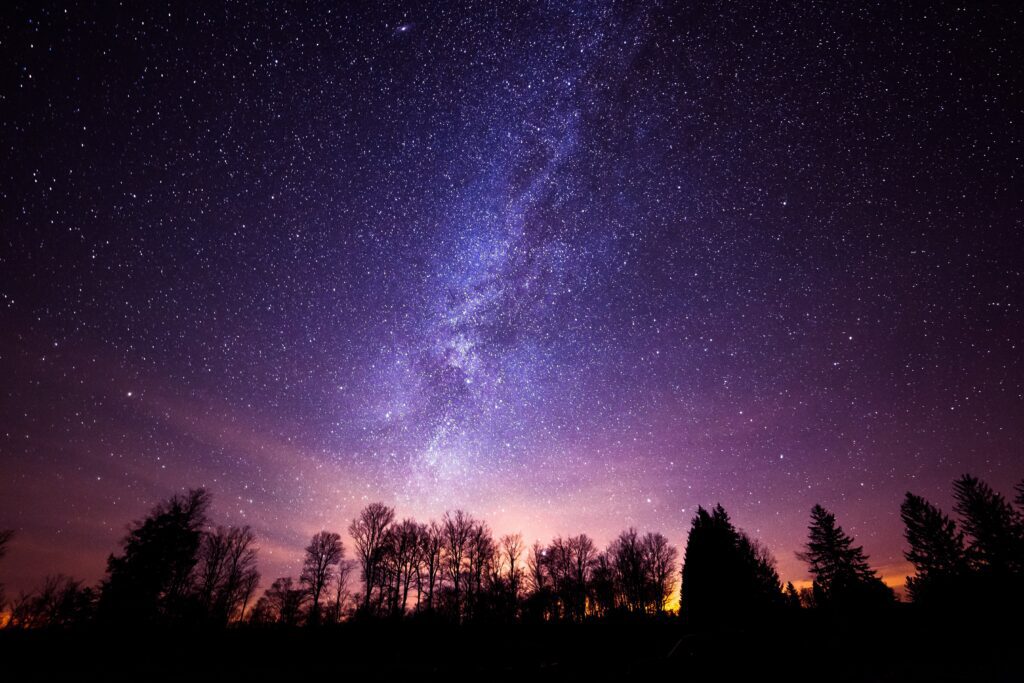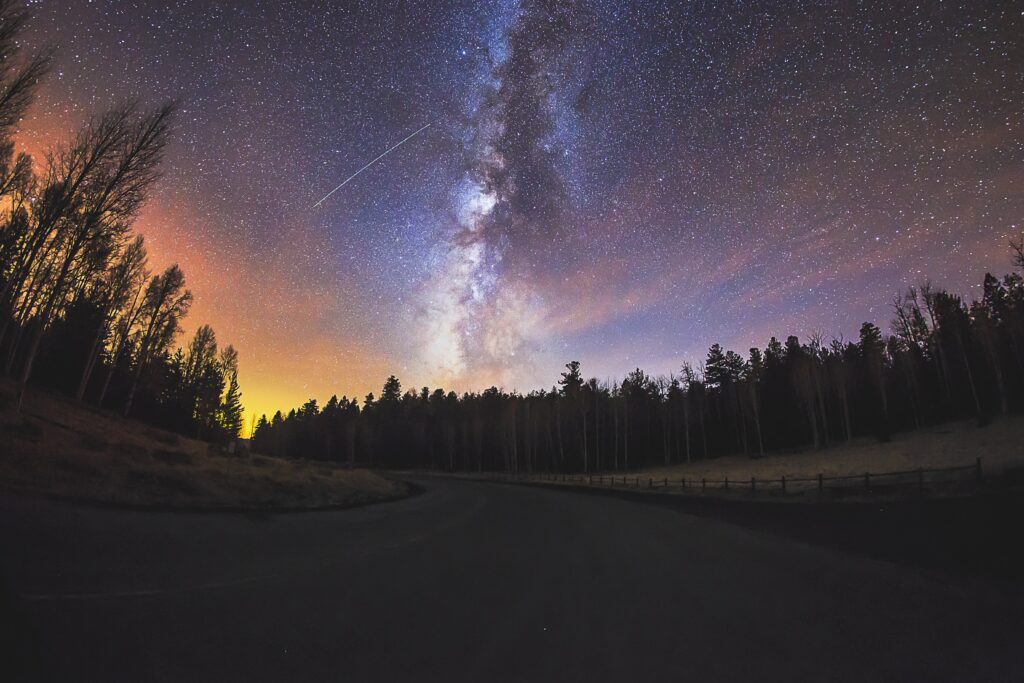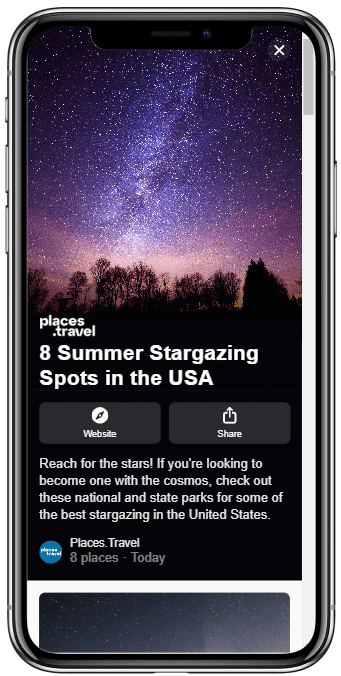To truly appreciate the majesty of the cosmos, you need one thing—true darkness. That can be hard to come by these days, thanks to the bright lights in our towns and cities.
If you’re looking for some of the best spots for stargazing, add these parks and towns to your bucket list.
National Parks
Great Basin National Park, Nevada
One of the most remote parks in the country, Nevada’s Great Basin National Park feels like another world. On a clear night, you could spot thousands of stars plus the Milky Way, the Andromeda Galaxy, and our near-ish planetary neighbors Mars, Saturn, and Jupiter. In winter, look for Orion and the Pleiades open star cluster.
Bring a telescope or rely on the naked eye at stargazing spots like Mather Overlook, which offers views down into the valley and up into the mountains. You can also set up at the Baker Archaeological Site, which is a wide-open expanse clear of trees for unobstructed views.
Each September, the Great Basin Astronomy Festival welcomes space enthusiasts to camp in the park for telescope viewing, talks by professional astrophysicists and astronomers, tours of the Great Basin Observatory, and much more!
Big Bend National Park, Texas
The sparse population around southwest Texas’ Big Bend National Park makes this the least light-polluted of any national park in the continental U.S. Bring comfy chairs and a pair of binoculars to the Sotol Vista with views across an open mesa. Or set up at the Rio Grande Overlook for unobstructed vistas of the sprawling Texas sky. You’ll get a spectacular show of 2,000+ stars, the Milky Way, meteor showers, constellations like Sagittarius, and even the neighboring galaxy Andromeda, depending on the season.
The park also offers fun ranger-led programs like star parties, telescope viewing and ranger talks, and moonlight walks through the desert landscape.
Canyonlands National Park, Utah

On the vast Colorado Plateau in the southwest’s Four Corners region, the scope of Canyonlands National Park puts things in perspective. With epic overlooks like Big Spring Canyon, Grand View, and Mesa Arch, you can spot thousands of stars across the neverending night skies.
Look for constellations like Cetus and Perseus in summer, Draco and Hercules in winter, and ample meteor showers throughout the year. On a clear night, you may even spot the rings of Saturn with just a pair of binoculars.
Each June, visit Southeast Utah Astrofest for a three-day astronomy festival across three parks, including Canyonlands, with ranger-led programs, telescope viewing, and constellation tours.
Big Cypress National Preserve, Florida
Spanning over 700,000 acres of swampland in southern Florida, Big Cypress National Preserve boasts some of the darkest skies east of the Mississippi River. Visit after dark to spot stars, constellations, and the glittering Milky Way. You’ll find spectacular views high above the swaying Florida palms from the Kirby Storter Boardwalk or the open prairie of Upper Wagon Wheel.
During the cooler winter months, the park hosts ranger-led astronomy programs like constellation tours and telescope viewing. Look for the Owl and Pleiades star clusters, planets, nebulae, and galaxies.
State Parks
Cherry Springs State Park, Pennsylvania
Set atop a 2,300-foot-high peak on the Allegheny Plateau of northern Pennsylvania, Cherry Springs State Park offers magnificent views after nightfall. Set up at the Night Sky Public Viewing Area for a short-term skywatch, or bring your equipment to the Overnight Astronomy Observation Field’s concrete telescope pads for 360° viewing all night long.

Depending on the season, you’ll spot constellations and asteroids, planets, the Northern Lights, the Andromeda and Milky Way Galaxies, and the International Space Station as it crosses the sky.
Visit in June for the annual Cherry Springs Star Party to connect with other amateur astronomers!
Staunton River State Park, Virginia
If you want a telescope experience but don’t have your own equipment, Staunton River State Park in southern Virginia has got you covered. Borrow one of their Newtonian-reflector telescopes for use in the park. You’ll also get a star map and a hands-on tutorial. Set it up at the field next to the visitor’s center to spot constellations like Ursa Minor and Piscis Austrinus, plus the Milky Way and meteor showers.
The park hosts twice-yearly star parties and events like monthly Stories of the Stars with Chapel Hill Astronomical and Observational Society (CHAOS) to teach beginners all about the night sky.
Watoga State Park, West Virginia
The word “Watoga” comes from a Cherokee word for “starry waters.” You’ll understand why that name stuck when you see the stars’ sparkling reflection in the lake at Watoga State Park. Hidden away in the secluded mountains of Pocahontas County, this park is surrounded by forests and wilderness, keeping the skies clear.
Camp overnight in a comfortable cabin or a rustic campsite, and soak up the night sky at the T.M. Cheek Memorial Overlook or the Ann Bailey Lookout Tower for spectacular views of the Milky Way and Triangulum Galaxies.
Visit in September to take part in the annual Star Party, where you can bring your own telescope or take a turn on shared equipment.
Headlands International Dark Sky Park, Michigan
At the northernmost tip of Michigan’s lower peninsula, Headlands International Dark Sky Park brings stunning stargazing to the shores of Lake Michigan.
During the main season, from May through Labor Day, astronomy staff set up telescopes on the viewing platform for public use. Or, bring your own equipment to look for Orion in spring, the Milky Way, Scorpion, and Sagittarius in summer, and meteor showers through the fall and early winter. You may also spot the Northern Lights around the spring and fall equinoxes.
The park hosts frequent programs from spring through fall, like “Satellites, Starlink, and Space Junk,” about humanity’s impact on near space. Spot images collected at the onsite Observatory at the event center during your program.
Cities & Towns
Westcliffe and Silver Cliff, Colorado
The twin towns of Westcliffe and Silver Cliff in southern-central Colorado are perfectly situated for exceptionally dark skies, tucked between two mountain ranges that block light pollution from nearby cities. These towns are the highest-elevation DarkSky places in the world!
Visit the Smokey Jack Observatory in Bluff Park, a small shed-like viewing spot with a retractable roof where you can observe the cosmos through their 14” state-of-the-art telescope. Attend monthly star parties in the warmer months to look for Scorpio, Sagittarius, Capricorn, and Aquila, plus the Milky Way.
Don’t miss the Planet Walk, a 4-billion-to-1 scale solar system exhibit that stretches through both towns to teach about our home system.
Flagstaff, Arizona

Surrounded by natural beauty and passionate about preserving Earth’s resources, it’s no wonder that Flagstaff in central Arizona was the first International Dark Sky City in the world. Thanks to decades of policies designed to limit light pollution, people have reported seeing the Milky Way from within the city!
These dark skies have attracted top astronomers, making Flagstaff home to Lowell Observatory, the U.S. Naval Observatory, and the Discovery Channel Telescope, among others.
Visit the Lowell Observatory to spot constellations through one of their many telescopes, including the 13” telescope that was used to discover Pluto in 1930! You can also bring your own equipment to sites like the Wupatki National Monument Parking Lot, where you can see from the western to the eastern horizon without obstructions.
Borrego Springs, California
Dark skies rely on deliberate policies, but location is also crucial. Borrego Springs in southern California is surrounded by 600,000 acres of desert, plus mountain ranges on three sides that block the brightness of big SoCal cities.
A top stargazing spot is The Springs at Borrego RV Resort, host to star parties with dinner, drinks, and guided stargazing. The annual Nightfall Star Party is another popular attraction each fall, hosted by the Riverside Astronomical Society with presentations and workshops throughout the weekend.
Take a personalized tour with noted astronomer and author Dennis Mammana, who will walk you through the stars and constellations overhead. Or venture out into the Anza-Borrego Desert State Park—also an International Dark Sky Park—to spot Orion and Taurus in February and Gemini and Leo in March.
Honorable Mentions
The red rocks of south-central Utah surround the tiny town of Torrey: population 257. Visit the nearby Capitol Reef National Park for nighttime hikes, astrophotography, or stargazing across the open desert. For a comfortable sky view, stay in one of Skyview Hotel’s Glamping Skylight Domes, where clear overhead panels let you soak up the night from the comfort of your bed.
One state over, Ridgway in western Colorado is an outdoor lover’s dream from sunup to long after sundown. Set up your telescope at the free community area Frontier Park with wide open views. Or head to Top of the Pines (TOP) Recreation Area, an International DarkSky Park at the foot of the Sneffels Wilderness Range. Spot the Milky Way, Orion, Sagittarius, and Scorpius over the crest of the mountains.

